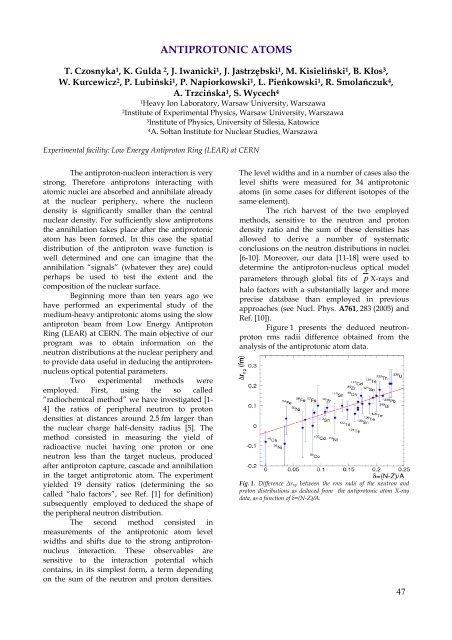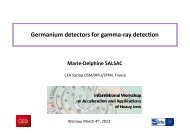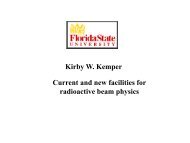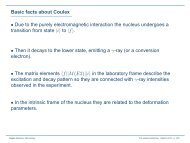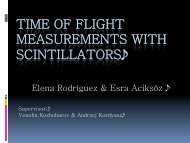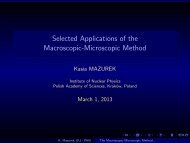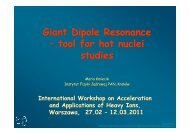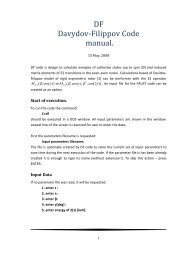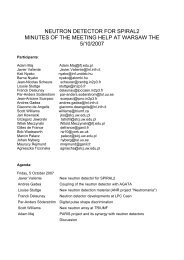nuclear physics in poland 1996 â 2006
nuclear physics in poland 1996 â 2006
nuclear physics in poland 1996 â 2006
- No tags were found...
Create successful ePaper yourself
Turn your PDF publications into a flip-book with our unique Google optimized e-Paper software.
ANTIPROTONIC ATOMST. Czosnyka 1 , K. Gulda 2 , J. Iwanicki 1 , J. Jastrzębski 1 , M. Kisieliński 1 , B. Kłos 3 ,W. Kurcewicz 2 , P. Lubiński 1 , P. Napiorkowski 1 , L. Pieńkowski 1 , R. Smolańczuk 4 ,A. Trzcińska 1 , S. Wycech 41 Heavy Ion Laboratory, Warsaw University, Warszawa2 Institute of Experimental Physics, Warsaw University, Warszawa3 Institute of Physics, University of Silesia, Katowice4 A. Sołtan Institute for Nuclear Studies, WarszawaExperimental facility: Low Energy Antiproton R<strong>in</strong>g (LEAR) at CERNThe antiproton-nucleon <strong>in</strong>teraction is verystrong. Therefore antiprotons <strong>in</strong>teract<strong>in</strong>g withatomic nuclei are absorbed and annihilate alreadyat the <strong>nuclear</strong> periphery, where the nucleondensity is significantly smaller than the central<strong>nuclear</strong> density. For sufficiently slow antiprotonsthe annihilation takes place after the antiprotonicatom has been formed. In this case the spatialdistribution of the antiproton wave function iswell determ<strong>in</strong>ed and one can imag<strong>in</strong>e that theannihilation “signals” (whatever they are) couldperhaps be used to test the extent and thecomposition of the <strong>nuclear</strong> surface.Beg<strong>in</strong>n<strong>in</strong>g more than ten years ago wehave performed an experimental study of themedium-heavy antiprotonic atoms us<strong>in</strong>g the slowantiproton beam from Low Energy AntiprotonR<strong>in</strong>g (LEAR) at CERN. The ma<strong>in</strong> objective of ourprogram was to obta<strong>in</strong> <strong>in</strong>formation on theneutron distributions at the <strong>nuclear</strong> periphery andto provide data useful <strong>in</strong> deduc<strong>in</strong>g the antiprotonnucleusoptical potential parameters.Two experimental methods wereemployed. First, us<strong>in</strong>g the so called“radiochemical method” we have <strong>in</strong>vestigated [1-4] the ratios of peripheral neutron to protondensities at distances around 2.5 fm larger thanthe <strong>nuclear</strong> charge half-density radius [5]. Themethod consisted <strong>in</strong> measur<strong>in</strong>g the yield ofradioactive nuclei hav<strong>in</strong>g one proton or oneneutron less than the target nucleus, producedafter antiproton capture, cascade and annihilation<strong>in</strong> the target antiprotonic atom. The experimentyielded 19 density ratios (determ<strong>in</strong><strong>in</strong>g the socalled “halo factors”, see Ref. [1] for def<strong>in</strong>ition)subsequently employed to deduced the shape ofthe peripheral neutron distribution.The second method consisted <strong>in</strong>measurements of the antiprotonic atom levelwidths and shifts due to the strong antiprotonnucleus<strong>in</strong>teraction. These observables aresensitive to the <strong>in</strong>teraction potential whichconta<strong>in</strong>s, <strong>in</strong> its simplest form, a term depend<strong>in</strong>gon the sum of the neutron and proton densities.The level widths and <strong>in</strong> a number of cases also thelevel shifts were measured for 34 antiprotonicatoms (<strong>in</strong> some cases for different isotopes of thesame element).The rich harvest of the two employedmethods, sensitive to the neutron and protondensity ratio and the sum of these densities hasallowed to derive a number of systematicconclusions on the neutron distributions <strong>in</strong> nuclei[6-10]. Moreover, our data [11-18] were used todeterm<strong>in</strong>e the antiproton-nucleus optical modelparameters through global fits of p X-rays andhalo factors with a substantially larger and moreprecise database than employed <strong>in</strong> previousapproaches (see Nucl. Phys. A761, 283 (2005) andRef. [10]).Figure 1 presents the deduced neutronprotonrms radii difference obta<strong>in</strong>ed from theanalysis of the antiprotonic atom data.Fig. 1. Difference ∆r np between the rms radii of the neutron andproton distributions as deduced from the antiprotonic atom X-raydata, as a function of δ=(N-Z)/A.47


